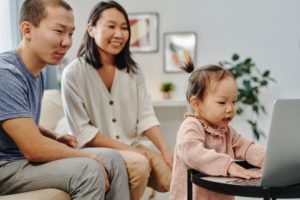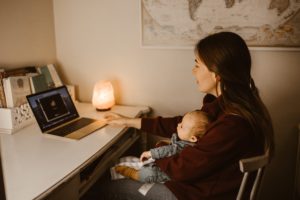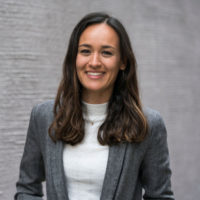As everything closed during the COVID-19 lockdowns, of course, our lab was no exception. With no safe way of further testing children and parents in our lab facilities, we had to bring the lab to our participants. With online yoga classes and family gatherings, we thought to ourselves: shouldn’t that work for our experiments as well?
The short answer is: Yes, it should, and it did (for some types of research)!

The longer answer: There is no one-size-fits-all way to do baby research online. Researchers all over the world got creative when facing the same question and they found multiple solutions, depending on their specific research question. For us, this meant scheduling appointments where parents and researchers meet via an online platform (e.g. Zoom). Just as in the lab, this let us see and hear what is happening on the other side of the screen, which allows us to figure out what children know about different aspects of language.
We adapted our habituation and preferential looking studies to this format. These are types of experiments where we measure either how long a baby looks at the screen, or which side of the screen they look at, so they weren’t too difficult to move online. During a scheduled online appointment, the researchers share our screen, so you and your child see, for instance, interesting pictures of objects on the screen and hear some words along with them. While you and your child watch the videos on your screen, we watch and code whether your child looks towards or away from the screen. And just like that, we have gaze and eye movement data of your child, telling us how interesting they found our stimulus material. After this quick looking task, we might ask you a few questions about your language background, and the whole study is completed, typically in about twenty minutes!
Some labs have even used online hosting platforms (such as Lookit and https://childrenhelpingscience.com) that allow families to view and complete studies on their own time, which makes scheduling them even easier. For this style of study, parents participate with their children whenever they want and researchers can go back and review the video later to analyze the results.

Of course, not every method is possible to adapt for remote research. For example, EEG, which measures electrical activity in the brain, requires a researcher to place electrodes on a participant’s scalp and cover them with gel, meaning a lot of close contact. Other fine-grained methods might need special equipment like an in-lab eyetracker that automatically records the very precise location a child looks.
While many labs are returning to in-person research, online studies have been a helpful tool during the last few years allowing us to pursue our curiosity about children’s language development. Even as we move into a world beyond lockdowns, we think online studies are here to stay! They’re much more convenient to schedule for researchers and families alike, and they allow more flexibility for families to participate outside of typical working hours and for people who can’t travel to a lab. This hopefully will eventually mean that our science is more diverse and represents more people overall. So, while we are beyond excited to welcome you back to our lab for live testing, we are still continuing our online studies. We hope this gives everyone who is interested a chance to participate, no matter how far or close they live to our lab.

Jessica Steil
Author
Jessica graduated from the University of Tübingen (Germany) with an M.S. degree in psychology. As a PhD candidate at the University of Tübingen, and a visiting scholar with Bergelson Lab, she is interested in infants’ language acquisitions and how young children think about their first words. Jessica enjoys hiking, books, and spending time with babies.
Elika Bergelson
Principal Investigator